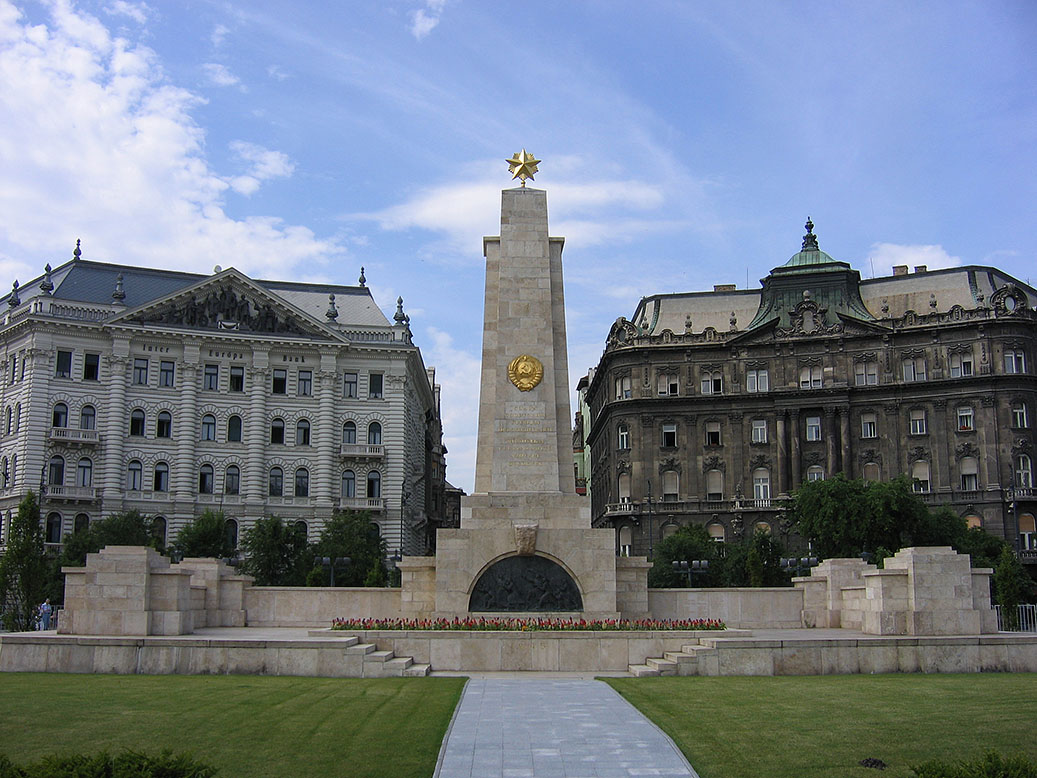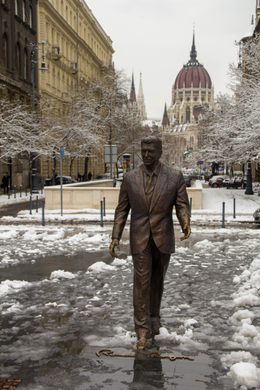
Art Historian Geza Boros said of the park:
The Memento Park is a museum of a historical era, simultaneously presenting the themes of dictatorship and democracy. The Memento Park was built according to the conceptual design of the architect Akoa Eleod. An “atmosphere of dictatorship” is created by these threatening monumental reminders of authority. However, in their new location, the positioning of the statues and accompanying buildings demonstrate to us that they are now simply the historical witnesses of the fact that there was once an era which expressed itself through these threatening symbols.
Park Layout
The park was built as designed by Eleod and is in two parts:
- Statue Park: A wall, the statues behind the wall, and an end wall, plus the road that “leads to nowhere”
- Witness Square: Trapezium-shaped main façade, with the statue park poem One Sentence About Tyranny by Illyes; the silence connoting “pain, grief, impotence, shame, shock, rage, and defiance.” On each side are the buildings for exhibits, tourist center, and educational center.
What I found
What I found was a fascinating collection of statues from two succeeding periods of 20th century Budapest history, post-World War II. This park is on very few itineraries of the typical tourist, is about a twenty-minute ride to the edge of town, and would appear upon first approach to look like an abandoned dump with overgrown weeds, dusty parking lot, and tall brick walls. Period music is piped into an otherwise eerie and quiet place. In the two hours we were there, only a pair of other travelers were seen who quickly scanned the area and then left. Of an annual 70,000 visitors, half are from Hungary, half from elsewhere.
The main portion of the park, where you pay a modest admission fee, is entered through the “behind the scenes” wall which opens into an open space. The main path leads to a back wall, and has three “figure eight” sections where the statues are positioned around the loops of the eight.

Across the street are barrack style buildings which tell stories of the park, and certain newspapers and posters. A film, secret police training from the communist era propaganda for trainees and informers, was on a continuous loop. The most prominent statue is of Stalin’s boots within a brick archway. Stalin was the Soviet Party First Secretary, Head of State, and General.
When the people rebelled against communist oppression and Soviet occupation on October 23, 1956, they sawed off the statue at the knees and tore it down.
The remaining boots were seen as a mockery of the dictator. This uprising was quickly squelched, but it is seen as the start of a cause that later led to the fight for national independence and eventually the fall of communist world order. Regime change in Hungary occurred relatively peacefully in 1988-90 when Russia leader Mikhail Gorbachev gave the countries of the Soviet block the freedom to choose their own way forward. By 1990, Hungary was again democratic and able to hold parliamentary elections once again.
You can see this for free and it is powerful to understand the scale involved in the original statue. It stood in the center of Budapest at Felvonulasi where parades and ceremonies were held on Communist National Holidays. Communist leaders stood on the balcony dias and saluted the marchers while the crown was required to celebrate and cheer them.
Individual Statues
There are a total of 42 statues at the park. These are among the major ones:
- Marx and Engels – this cubist style granite monument of the two figures who wrote the Communist Manifesto once stood beside the headquarters of the Communist Party from 1956-1990
- Lenin
Upon Lenin’s death in January 27, 1924, a cult of devotees set off to erect statues and monuments in his honor, streets and public squares renamed for him, and songs and poems written in his praise. Cities were renamed (St. Petersburg became Leninburg). Leninism became like a state religion, whose true purpose was to ensure power to his successors responsible for carrying on his legacy. Youth were a particular target for this propaganda.
The Lenin statue once stood in the centre of the Soviet Pioneer Camp in Balatonszemes, Hungary, open only to children. Behind the statue was a fifteen-foot concrete wall with red granite veneer. This statue, originally taken down for repairs, was destroyed instead. Other statues of Lenin, the symbol of socialist and communist beliefs and ideology, were erected in every capital, town square along with portraits in offices and school classrooms. - Role Model workers movement sculptures – these were fashioned throughout the Eastern-European countries to signify the ideals and legacies and members of the communist workers movement that would serve as role models.They are usually accompanied by the five pointed red star. Some were in the form of reliefs on building sides. These become fallen heroes, whose statues, street names, and squares were in need of change after the fall of communism. Many were destroyed or “hung from a tree” at that point and some were stored in a closet, only to be found later.
- Worker’s Movement Memorial – Two hands encircling a ball (representing perfect ideology).
- Monument to the Hungarian Socialist Republic – Bronze sculpture names “To arms” is a huge figure who appears to be running after something, a long cloth in his left fist. It was originally located in a city park near Felvonulasi ter.

Takeaways
This is an outstanding example of a way to tell the story of multiple sides of a difficult history. These are factual pieces of history, and much is known about the subject, purpose, artist, and materials. They are significant in their individual realms, but more so as a “collection.”
I could see this being done elsewhere, such as with the confederate statues that are removed. Their disposition can help enhance and tell history by better understanding what they were for and why they were opposed.
Reference: In the Shadow of Stalin’s Boots: Visitor’s Guide to Memento Book, Private Planet, ND

I am often asked how it came to be that I wrote a book about statues. My simple response is that I became interested in the taking down of the confederate statues, but beyond that, it became an interest in the place those statues held in their community, the discussions surrounding their removal, and where to “dispose” of them. This last feature is rarely featured, perhaps because it is a story still unfolding.
But in Europe this is not a new story at all and they have had decades to consider the options when a statue is removed. There is no one answer, but since this topic is so new in America, it bears wider understanding. I had the opportunity to visit an important outdoor museum of removed sculptures in Budapest Hungary, known as Memento Park. I understand there may be a smaller park in Moscow and single “saved” statues in places such as Lithuania.
Historical Era of Communism and the Aftermath of its Fall
By way of brief history, Hungary finished WWII in 1945 on the losing side. When Europe was divided up, Hungary fell to Russia for governance. The Soviets occupied the county for forty-five years and closed off the populace by the “Iron Curtain.” Border crossings were nearly impossible and subject to searches and interrogation. Barbed wire fencing and electronic warning systems were everywhere, escapees were shot, thus keeping the Hungarians captive in their land. But in 1989 the Hungary/Austrian border was opened up to East German refugees and eventually everyone, and mass exodus ensued. Elsewhere, the Berlin Wall collapsed and the two Germanys were reunited.
When the Eastern European dictatorships fell, the fate of thousands of public memorials to communism became an important issue. One option, the obvious one, was complete destruction. This was rejected by the city council who resolved to create a theme park for documentary value and an inventory was made by a committee of mayors and local cultural committees. 42 statues were identified to become the basis of the Statue Park. Debates ensued and opinions exchanged as to what the park would look like. Two options emerged: one was to portray it as a “shame-type” and the other was an “irony park.”
Neither of these was realized when architect Akos Eleod came forward with the concept that the park would represent, “one sentence about tyranny.” People from opposing views united in agreement that the concept was a “shining example of how to culturally and elegantly display a sensitive subject.” The layout was purposeful to simultaneously call forth the atmosphere of dictatorship and to provide an opportunity for critical analysis. Memento Park opened June 27, 1993, the second anniversary of the end of the Soviet occupation. At about the same time, it was decided that the statues from the Hungarian countryside would be placed in local historical museums and collections, placed on top of tombs of Soviet soldiers, or put into storage.







